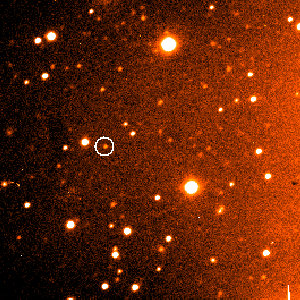Kaliban (księżyc)
| ||
 Fragment zdjęcia, dzięki któremu odkryto księżyc, z zaznaczeniem jego położenia. | ||
| Planeta | Uran | |
| Odkrywca | Brett Gladman, Philip Nicholson, Joseph Burns, John Kavelaars[1] | |
| Data odkrycia | 6 września 1997[1] | |
| Tymczasowe oznaczenie | S/1997 U1 | |
| Charakterystyka orbity | ||
| Półoś wielka | 7 231 100 km[2] | |
| Mimośród | 0,1812[2] | |
| Okres obiegu | 579,73 d[2] | |
| Nachylenie do ekliptyki | 141,529°[2] | |
| Długość węzła wstępującego | 171,189°[2] | |
| Argument perycentrum | 354,339°[2] | |
| Anomalia średnia | 7,271°[2] | |
| Własności fizyczne | ||
| Średnica równikowa | 72 km[3] | |
| Średnia gęstość | 1,5 g/cm³[3] | |
| Okres obrotu wokół własnej osi | 2,7 h | |
| Albedo | 0,04[3] | |
| Jasność obserwowana (z Ziemi) | 22,4m[3] | |
Kaliban (Uran XVI) – zewnętrzny, nieregularny księżyc Urana, poruszający się ruchem wstecznym. Został nazwany od imienia postaci ze sztuki Burza Szekspira[1].
Kaliban został odkryty 6 września 1997 roku przez Bretta J. Gladmana, Philipa D. Nicholsona, Josepha A. Burnsa i Johna J. Kavelaarsa przy pomocy 200-calowego teleskopu Hale’a. Zespół ten w tym samym czasie odkrył też większy księżyc Sykoraks[1].
Zobacz też
Przypisy
- ↑ a b c d Caliban (ang.). W: Solar System Exploration [on-line]. NASA. [dostęp 2018-12-25].
- ↑ a b c d e f g Planetary Satellite Mean Orbital Parameters (ang.). Jet Propulsion Laboratory, 2013-08-23. [dostęp 2016-02-12].
- ↑ a b c d Planetary Satellite Physical Parameters (ang.). Jet Propulsion Laboratory, 2015-02-19. [dostęp 2016-02-12].
Linki zewnętrzne
- Caliban (ang.). W: Solar System Exploration [on-line]. NASA. [dostęp 2018-12-25].
Media użyte na tej stronie
This is a revised version of Solar_System_XXIX.png.
This image of Uranus was compiled from images returned Jan. 17, 1986, by the narrow-angle camera of Voyager 2. The spacecraft was 9.1 million kilometers (5.7 million miles) from the planet, several days from closest approach. This picture has been processed to show Uranus as human eyes would see it from the vantage point of the spacecraft. The picture is a composite of images taken through blue, green and orange filters. The darker shadings at the upper right of the disk correspond to the day-night boundary on the planet. Beyond this boundary lies the hidden northern hemisphere of Uranus, which currently remains in total darkness as the planet rotates. The blue-green color results from the absorption of red light by methane gas in Uranus' deep, cold and remarkably clear atmosphere.
This shows the discovery image of Caliban a faint moon of Uranus. It is designated as S/1997 U 1 and was later named Caliban. The glare from Uranus, which was placed intentionally off the frame to avoid saturating the detector, is visible at the right.



